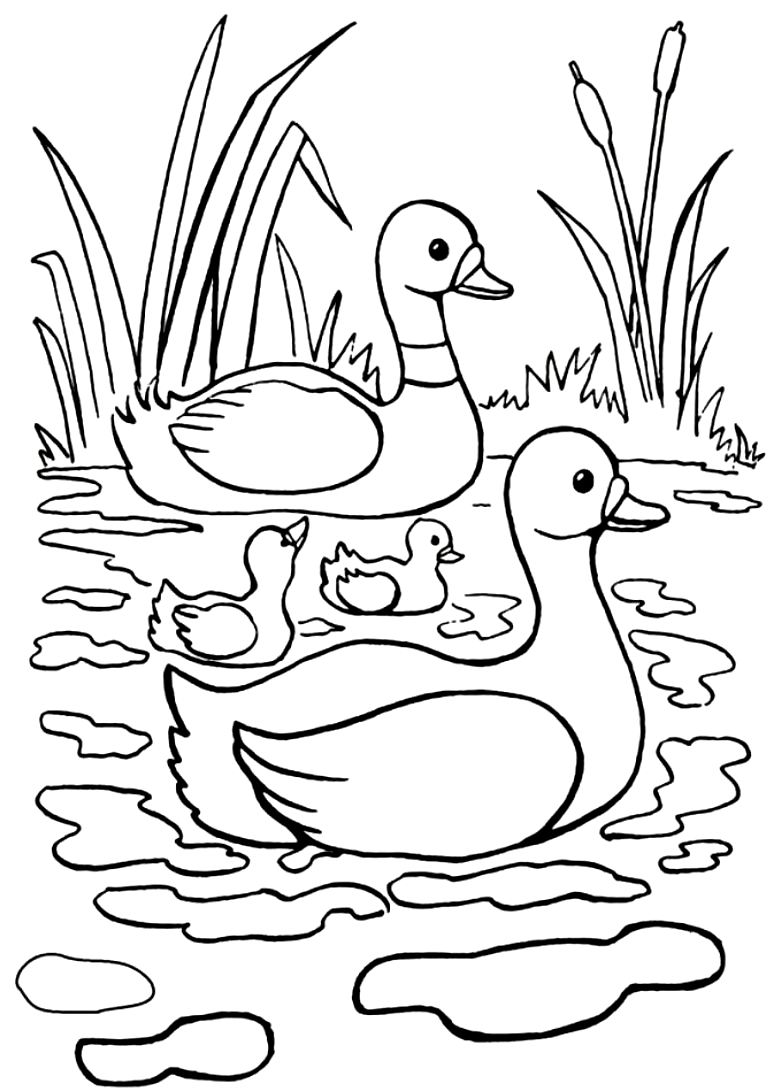Ducks
Free printable Ducks coloring pages (Best coloring books). Ducks are very sweet and beautiful domestic and wild animals. We have put together duck coloring pages for you. We will both give information and share the coloring pages about our cute friends who waddle and start swimming when they see water. Some colors will take care of our work while working with the duck coloring page. I can summarize these colors mostly as green, blue, brown, black and gray.
Ducks coloring pages ( Free printable sheets)
Duck breeds, there are more than a hundred wild and domestic duck breeds living in wetlands all over the world. The most well-known duck breeds are spoonbill, mallard, pintail, large saw-billed, musk duck, black duck. These webbed-footed bird species especially like swampy areas near lakes and streams. Domestic breeds of ducks have been produced because they are easy to feed and adapt to climatic conditions and are profitable at the same time. Duck breeds in our country are hybrid breeds obtained from the mixture of many breeds.
It is found in pure breeds such as Pekin, Ruen, Kampbel that have been bred in the world. Domestic duck breeds were obtained from wild green head duck. Ducks have flat beaks, webbed feet, and distinctive gaits and voices. Due to their short feet on the back of their body, they have difficulty walking especially. For this reason, there is a special walking style called body walking. Duck breeds have a nice appearance because they carry white, green, blue, black and some of the other colors on them. However, females are more plain and dull in color. Domestic musk ducks fed in America are only white in color. In winter, the male duck sheds its feathers and has dark-colored feathers like the female.
Although it is known that there are different types of ducks in every region, there are various types in almost many regions of the world.
We can list some of these varieties;
silver duck, summer duck, spoonbill duck, Cinnamon-colored duck, Baikal duck, spinning wheel duck, pintail duck, Bahamian duck, chestnut duck, chile duck, ringed duck, Fiyu duck, mandarin duck, heaven duck, Crested Patka Duck, Hungarian duck, Angit duck, manet duck, pintail duck, upright duck, manet duck, Suna duck, Pochard duck, Radjah duck, mallard, mandarin duck
There are many types of ducks. Since the feathers are stacked on top of each other in duck breeds, it is waterproof and water glides easily on it. It helps these water-loving birds to stay dry all the time. Ducks get their lubricity from the sebaceous glands on their tails and apply it to their feathers with their beaks. They swim and dive quite well. Their breasts are protruding forward and their back is compressed from the upper side. They are just like a boat. The flat and wide beak is covered with skin filled with nerves, the margins are serrated. When they dive into the water, they search the mud inside. They take the muddy water into their mouths, close their beaks, and leak the muddy water out at certain times with their tongue. Meanwhile, maggots and seeds in muddy water remain in the mouth. In fact, all duck breeds eat whatever they can find. They are known as gluttonous birds. Because they do not have crops, they digest very quickly. Some species of ducks living in the sea feed on fish and shellfish. In the water, the breathing hole on its beak closes. Although they have difficulty walking on land, their movements in water are quite rapid.
Domestic duck breeds do not fly and do not nest. Wild species make their nests in bushes and tree cavities. Mallard ducks nest in holes left by rabbits and lay eggs there. Wild species live in groups, and when winter comes, they migrate to warm places in flocks. Domestic breeds can live up to 15 years, while wild breeds can live 20-30 years.
Duck Features
Ducks swim very well thanks to their rather short legs and webbed feet. However, it is rather clumsy to walk on land. Domestic ducks have stronger legs than wild ones. In some species, the beak is cut on the sides, which facilitates the hunting activity of small fish. In the upper part of the beak there are small holes that interfere with the respiratory process and explain the production of the ducks' recognizable squeak.
The duck's body is rather rounded and sometimes covered with white or other shades of brown or black, and sometimes with striking bluish and greenish feathers. Males usually have more colors than females. Ducklings are usually yellow with an orange beak, there are also black colored pups. The colors of the beak are variable. These colors can be orange, red and black.
Duck Life
Duck lifespan is known to be about 4 to 6 years. However, the life span of wild ducks can reach 8 years. Ducks that have been domesticated on farms can live up to 12 years. The reason for this is that their nests are constantly cleaned. Although it is not known as a dirty animal, cleaning and pest control in the farms ensure that their lifespan is longer.
Interesting Facts About Ducks
There is a lot of interesting information about ducks. It is one of the few bird species that both fly and live dependent on water. The dense hairs on the abdomen make it easier to swim on the water in cold weather. The reason for this is that there is no decrease in body temperature thanks to the dense hair. These feathers are naturally waterproof. While swimming on the water, they can see the fish under the water. They live in herds and migrate at certain times of the year. They can fly up to 2000 miles in one go without stopping. Their wingspan can reach 120 cm and they can fly an 8,000-mile journey with 2 rest stops. They are highly resilient animals and, like geese, are monogamous.
















